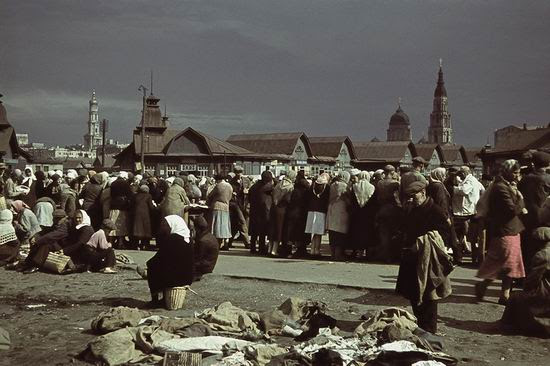
On the seventieth anniversary of the German invasion of the Soviet Union, the beginning of the Great Patriotic War – the date is not identical with that of the intervention of the Soviet Union in the Second World War which took place two years earlier, on 17 September 1939 with
the invasion of Poland – I am browsing with curiosity the Russian sites, whether the round anniversary has brought to light some hitherto hidden or lesser-known material. And it has.
Flackelf has published a color (!) photo series of surprisingly high quality, made by a professional photographer on the everyday life of
the city of Kharkov occupied by the German army.


Kharkov on the map of the modern Ukraine, from the Wikipedia |
Kharkov, then Ukraine’s largest city and the third largest industrial city in the Soviet Union – the center of tank industry, which was evacuated in time to the Urals – was occupied by the German army in very heavy fighting on 24 October 1941. The Red Army tried to take it back in May 1942, but they succeeded only in February 1943. However, in March the Germans reoccupied the city, which was definitely liberated only in August. In the five great battles of Kharkov more people – military and civilian – died than in any other theater of the war, including Stalingrad. Kharkov
supposedly did not get the title of “hero city” only because Stalin considered it a disgrace that the Red Army was able to occupy it only for the third attempt. About half of the sixty thousand Jews of Kharkov managed to escape still in time; those who remained were
shot into a mass grave on 15 December 1941. After the liberation only two hundred thousand persons were left alive in the city, which has still not reached again its pre-war population number of one and half million.

The major part of the photos were taken the day after the Germans’ entry into the city, on 25 October, and they show the new German inscriptions, the burnt-out buildings, the shot tanks already taken in possession by the children, the everyday life of the city center and of the market place, those waiting for a ferry next to the blown up
Lopan Bridge – with an attentive eye and rich in details so that it is worth to click on each. But three pictures show a strange ceremony: German soldiers carry a black coffin through the city, accompanied by the music of accordion, and they set it smiling on fire with pseudo-Lutheran pseudo-ceremony on the military airport. If you know what this might be, please tell it.
The thirteen black and white pictures following the color ones are not part of the series, but belong to the military photos of the Bundesarchiv. Nevertheless, according to their dates – which for some reason were cut off in this publication – they were mostly taken in the same days, at the time of the siege of Kharkov and of the entry of the German army.








































Da rimanere senza fiato per la bellezza di queste immagini (come sempre, qui dentro). Grazie.
ResponderEliminarI love your blog! One note: I think the 4th photo has been taken in Zhytomir.
ResponderEliminar